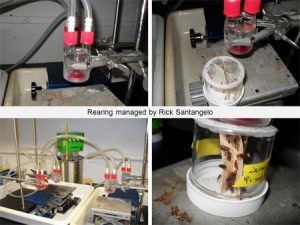Schal Lab Resources
Our lab maintains a small collection of pest, temperate, and tropical cockroach species, and several colonies of bed bugs, including various strains recently collected in apartments in various US locations. The Insectary within the Department of Entomology and Plant Pathology, housed in the Biological Resources Facility, also maintains other exotic insects for display and outreach activities. We welcome requests from non-profit organizations for cockroaches to be used in educational programs.
List of cockroach species in culture
Blaberidae
| Blaberus atropos (Blaberus fusca) | Gromphadorhina portentosa |
| Blaberus craniifer – Death’s head cockroach | Leucophaea (Rhyparobia) maderae |
| Blaberus giganteus – Central American giant cave cockroach | Nauphoeta cinerea |
| Blaptica dubia – Argentinian wood roach | Pycnocelus indicus |
| Diploptera puncata – Pacific beetle cockroach | Pycnocelus surinamensis |
| Eublaberus posticus – Orange head cockroach | Schultesia lampyridiformes |
Blattidae
| Periplaneta australasiae – Australian or Australasian cockroach | Periplaneta fuliginosa (collected locally) – Smokybrown cockroach |
| Periplaneta americana (collected locally) – American cockroach | Blatta orientalis (collected locally) – Oriental cockroach |
| Shelfordella lateralis (Blatta lateralis) – Turkestan cockroach |
Ectobiidae
| Blattella germanica (many strains) – German cockroach | Parcoblatta latta (collected locally as needed) |
| Blattella asahinai (collected locally) – Asian cockroach | Parcoblatta pennsylvanica (collected locally as needed) |
| Blattella lituricollis – false German cockroach | Supella longipalpa (collected locally) – Brown-banded cockroach |

Bed bugs
Our lab maintains dozens of strains of bed bugs, including the Harold Harlan strain, an insecticide-susceptible strain collected by Dr. Harlan in 1973 at Ft. Dix, NJ. Bed bugs are maintained completely “in vitro” without use of animal hosts. We use custom-made jacketed glass feeders and human blood. We shifted from rabbit to human blood to enable metabolomics, proteomics and microbial ecology work under more realistic conditions.
Contact Coby Schal or Rick Santangelo for more information. We gladly share protocols and bugs.
Lab facilities
Our lab is located in Gardner Hall, on the North Campus of NC State. It contains a separate insect rearing room, a microscopy/physiology room, a chemical ecology/biochemistry room and a behavioral assay section, which alleviates problems of cross-contamination with pheromones and hormones. The behavior lab consists of a walk-in temperature and humidity microprocessor-controlled room and 7 reach-in incubators. We are fully equipped for cockroach and bed bug rearing and maintenance.
The Biological Resources Facility houses small animals and generates antibodies on a fee-for-service basis. We maintain a BSL-2 lab in this facility, which is dedicated to bed bug feeding and maintenance.
Analytical equipment
Equipment in our lab includes, among others:
- Two HP1050 HPLCs, with diode array detectors (old, but reliable)
- Bio-Tek PowerWave 200 microplate scanning spectrophotometer (old, but used by many)
- Agilent 6890 (S/SL, FID) and 7890 (S/SL, on-column, FID) capillary GCs, each with a HP7683 auto-injector
- Agilent 6890 GC coupled to an Agilent 5975 MSD with both EI and CI capabilities
- Agilent 7890 GC-EAD system (S/SL, FID) (home made coupling and amplification)
- Syntech TasteProbe station for gustation research
- P160N, HK160 and MP8-1 digital balances
- Centra CL5R centrifuge, and several microfuges
- Zeiss and Nikon SMZU dissecting microscopes with fiber optics
- Ultrasonic and manual tissue disrupters
- Bio-Rad electrophoresis systems
- Brinkman Polytron homogenizer
- Jouan RCT60 concentrator
- Several freezers including -80oC freezers
- Various molecular biology and microbiology equipment
Behavioral equipment includes:
- Several IR sensitive cameras and high resolution monitors
- Digital video recorders
- Noldus’s EthoVision and The Observer packages.
